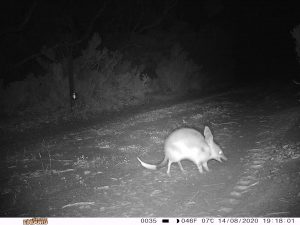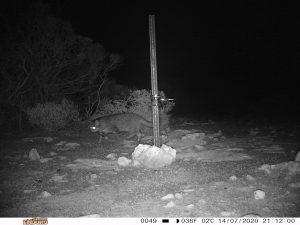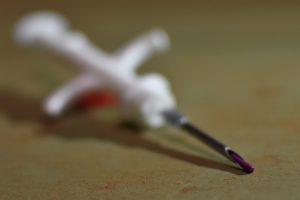

Ned Ryan-Schofield, a Masters student at the University of Adelaide, has been provided a grant to assist with his project aimed to determine the effectiveness of a poison delivery system that targets individual feral cats that repeatedly kill the same type of prey.
Project Summary
Feral cats are a significant cause of native species decline. To protect native animals a ‘population protecting implant’ (PPI) has been developed. This microchip-sized capsule will be implanted under the skin of a native animal. It is made from 1080 poison coated with a polymer that remains stable under the skin of a native animal but degrades upon reaching a predator’s stomach. This new technology has the potential to significantly improve reintroduction success of threatened species and protect remnant populations of wildlife, by removing the feral cats that have learnt to hunt threatened prey, stopping them from systematically eliminating small populations. We have conducted lab trials of the PPI’s in solution and in vivo trials in lab rats but in order to register this project for widespread use in conservation programs we need to provide evidence regarding the safety and efficacy of the implants in the field to the Australian Pesticides and Veterinary Medicines Authority (APVMA). This project aims to field-test the PPI’s, and evaluate their effectiveness as a poison delivery system in an applied setting to protect a population of the Greater Bilby (Macrotis lagotis), a threatened species vulnerable to cat predation.
Background
Feral cats have been implicated in approximately two thirds of Australian mammal extinctions, and another 54 mammal taxa are seriously threatened by cat predation. Consequently, feral cat predation is considered the single most significant threat to Australian mammals (Frank et al. 2014; Woinarski et al. 2015).
Current methods of controlling feral cats for conservation such as exclusion fencing, trapping, or shooting are not feasible at a landscape scale, while broad-scale poison baiting using specially formulated cat baits (Algar et al. 2013) is typically ineffective when alternative prey are available, as cats prefer to satisfy their high protein and water requirements from live prey or fresh meat. Furthermore, cat baiting is necessarily limited to environments or seasons where bait removal or effects on scavenging non-target species can be mediated (McGregor et al. 2014, 2015), while sustained control of cats through use of poisoned baits also suffers from the conundrum that efficacy is likely to decline as prey populations recover and alternative food becomes available.
Simply reducing predator density in areas of conservation priority may also fail to sufficiently reduce predation rates, as the effects of cat predation can be exacerbated by individuals that specialise in their prey selection on threatened species. Even only a few remaining feral cats are able to cause local extirpation of highly predator susceptible species. For example, although successful reintroductions of mammals such as the greater bilby (Macrotis lagotis), bettong (Bettongia spp.), and stick-nest rat (Leporillus conditor) have occurred when species are reintroduced into fenced reserves or islands where feral cats are absent (Copley 1999; Moseby et al. 2011a; Hayward et al. 2014), there is a litany of failed mammal reintroduction attempts, including bandicoots (Isoodon spp.), mala (Lagorchestes hirsutus), and long-haired rats (Rattus villosissimus) (Christensen & Burrows, 1995; Gibson et al. 1995; Frank et al. 2014) into areas where even low abundance of introduced predators are present, and despite, in many cases,intensive introduced predator control being used (Morris et al. 2004; Moseby et al. 2011b; Wayne et al. 2015; Hardman et al. 2016; Short 2016). Moseby et al. (2015) documented multiple cases where threatened-species reintroduction programs were thwarted by predation by only one or a few individual cats, while other cats exerted little or no predation pressure.
Because these individual ‘’catastrophic’ cats (sensu Moseby et al. 2015) can learn to hunt then repeatedly kill prey, even low numbers of cats are able to threaten the viability of small in situ and reintroduced populations. A subcutaneous toxic implant (a ‘population protection implant’, or PPI) that remains inert in the tissue of an animal but will break down in the acidic stomach of a cat has been developed for strategically poisoning these problem cats (Read et al. 2015). These implants could be inserted during routine monitoring of extant or reintroduced native species. Using live prey with toxic implants rather than dried meat baits will reduce non-target impacts, as only predators that prey upon the implanted species and are vulnerable to 1080 will be affected. Most native species have evolved a high tolerance to 1080 (including native predators) but introduced species such as feral cats are particularly susceptible. If implanted animals are killed and consumed the predator will be poisoned by the implant, hopefully removing the individual ‘catastrophic’ cats, thereby preventing them from systematically eradicating threatened prey populations. Additionally, unlike the declining efficacy of meat baits as prey population recovery occurs, a continued supply of toxic prey at cat hunting foci should maintain control rates. Therefore, rather than feral cat control zones enhancing prey availability that likely diminishes the efficacy of subsequent cat management, the foci of implanting activities will provide local ‘predator sinks’ to which immigrating cats will be vulnerable, and hopefully removed.
Methods
To demonstrate effective uptake of PPI’s and removal of feral cats at a landscape scale, up to 30 bilbies within a fenced conservation area will be implanted. The area has had significant trouble with incursions, and so low densities of cats remain and are a threat to bilbies. We will value add to a reintroduction project by implanting up to 20 bilbies with PPI’s prior to their release into the area, in an effort to improve reintroduction outcomes.
Bilbies will be fitted with tail transmitters upon release, and radio-tracked daily for the first month after release. Survivorship of Bilbies will be recorded, as all collars will include a mortality sensor that activates if the animal does not move for 10 hours. Determining cat uptake of PPIs will be measured by examining any bilby carcasses for presence or absence of PPIs and measuring cat survival on remote infrared cameras. A camera grid of 20-40 cameras will be established in the area for 3 months prior and 3 months after the trial. Capture mark resight analysis will be conducted on camera photos of cats and compared with the timing of bilby deaths from cat predation, to assess whether uptake of a PPI coincides with failure to detect an individual cat from the camera array.
To gather multiple lines of evidence, DNA samples will also be taken using cotton buds dipped in Tissue Digest (DXT) (Qiagen) and swabbed over any open wounds on the carcasses of any bilby carcasses recovered. Roughened wooden stake hair-snares will also be set at each remote camera deployment and sprayed with cat urine, to entice cats to rub. Hairs will be collected, and any that contain roots extracted for DNA. Thus, we will be able to detect the presence of individuals before and after a bilby mortality, and hopefully demonstrate that the DNA signature from swabs is detected on hair-snares before but not after bilby mortality, indicating successful uptake of the PPI.

